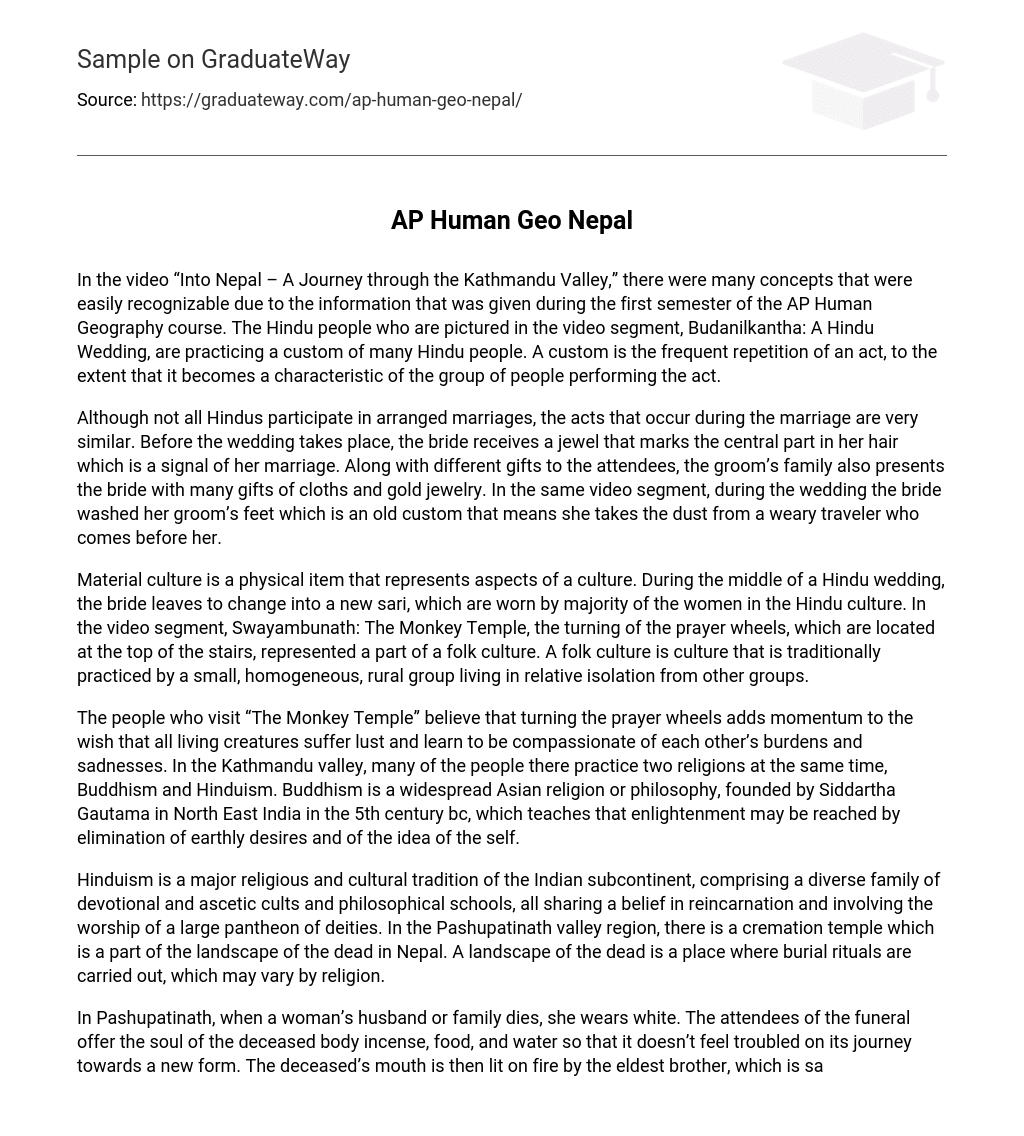The video “Into Nepal – A Journey through the Kathmandu Valley” depicted several familiar concepts from the first semester of the AP Human Geography course. In the segment titled “Budanilkantha: A Hindu Wedding,” Hindu individuals were seen practicing a custom that is common among many Hindu people. A custom refers to the regular repetition of an action, to the point where it becomes a defining characteristic of the group engaging in the act.
Although not all Hindus participate in arranged marriages, the acts that occur during the marriage are very similar. Before the wedding takes place, the bride receives a jewel that marks the central part in her hair which is a signal of her marriage. Along with different gifts to the attendees, the groom’s family also presents the bride with many gifts of cloths and gold jewelry. In the same video segment, during the wedding, the bride washed her groom’s feet which is an old custom that means she takes the dust from a weary traveler who comes before her.
Material culture is a physical item that represents aspects of a culture. During the middle of a Hindu wedding, the bride leaves to change into a new sari, which is worn by the majority of women in Hindu culture. In the video segment, Swayambunath: The Monkey Temple, the turning of the prayer wheels, located at the top of the stairs, represents a part of folk culture. Folk culture refers to culture that is traditionally practiced by a small, homogeneous, rural group living in relative isolation from other groups.
“The Monkey Temple” is a renowned spot for believers who use spinning prayer wheels to express their desires for all beings to conquer desire and foster compassion towards each other’s hardships and sorrow. In the Kathmandu valley, there exists a considerable population that simultaneously practices Buddhism and Hinduism. Buddhism, originating from Siddhartha Gautama in North East India around the 5th century BC, is a widely followed religion or philosophy that focuses on achieving enlightenment by renouncing worldly desires and understanding the concept of self.
Hinduism, the primary religious and cultural tradition of the Indian subcontinent, encompasses diverse ascetic cults, devotional practices, and philosophical schools. Regardless of their distinctions, these groups all embrace the concepts of reincarnation and devotion to multiple deities. In Nepal’s Pashupatinath valley region lies a cremation temple that forms part of a designated landscape for paying tribute to the departed. This landscape serves as a location for burial rituals that differ according to individual religious convictions.
When a woman in Pashupatinath loses her husband or family, she adorns herself in white clothing. At the funeral, those in attendance provide incense, food, and water as offerings to ensure the soul of the deceased does not face trouble during its transition to a new existence. The eldest brother performs a ritual by igniting the mouth of the departed, believed to cleanse their soul. Additionally, there are individuals known as river cleaners who search for gold fillings extracted from the teeth of those who have passed away. Pashupatinath valley is also a dwelling place for numerous saddus.
They are individuals in the final stage of their lives, living without any possessions and dedicating their lives to prayer. Their days are filled with meditation and yoga, practices believed to aid in concentration and purification. It is likely that many of the saddhus have embarked on a pilgrimage to the valley, a journey to a sacred place for religious reasons. The culture of the villagers residing at the base of the Himalayas may appear peculiar to outsiders.
Culture encompasses the customary beliefs, social norms, and material characteristics that form the unique heritage of a community. The community members construct pathways through their footsteps, while animals contribute milk and haystacks serve as drying spots for clothing. The women gather bundles of dried cornstalks to nourish a buffalo or assist in repairing roofs and stuffing mattresses. Additionally, within this village, there exist several boys who possess proficiency in both English and Nepali, rendering them multilingual individuals. Multilingual individuals are those who fluently speak two or more languages.
The narrator was greatly assisted by two English-speaking young boys in the video, as most villagers in Kathmandu spoke Nepali. The video portrayed numerous small villages in Kathmandu as preliterate societies, meaning they do not have a written language. The children in these villages acquire a significant amount of knowledge by observing their elders. Nevertheless, in the city where the marketplace is located, many children attend school where they likely learn basic education such as reading, writing, and arithmetic.





